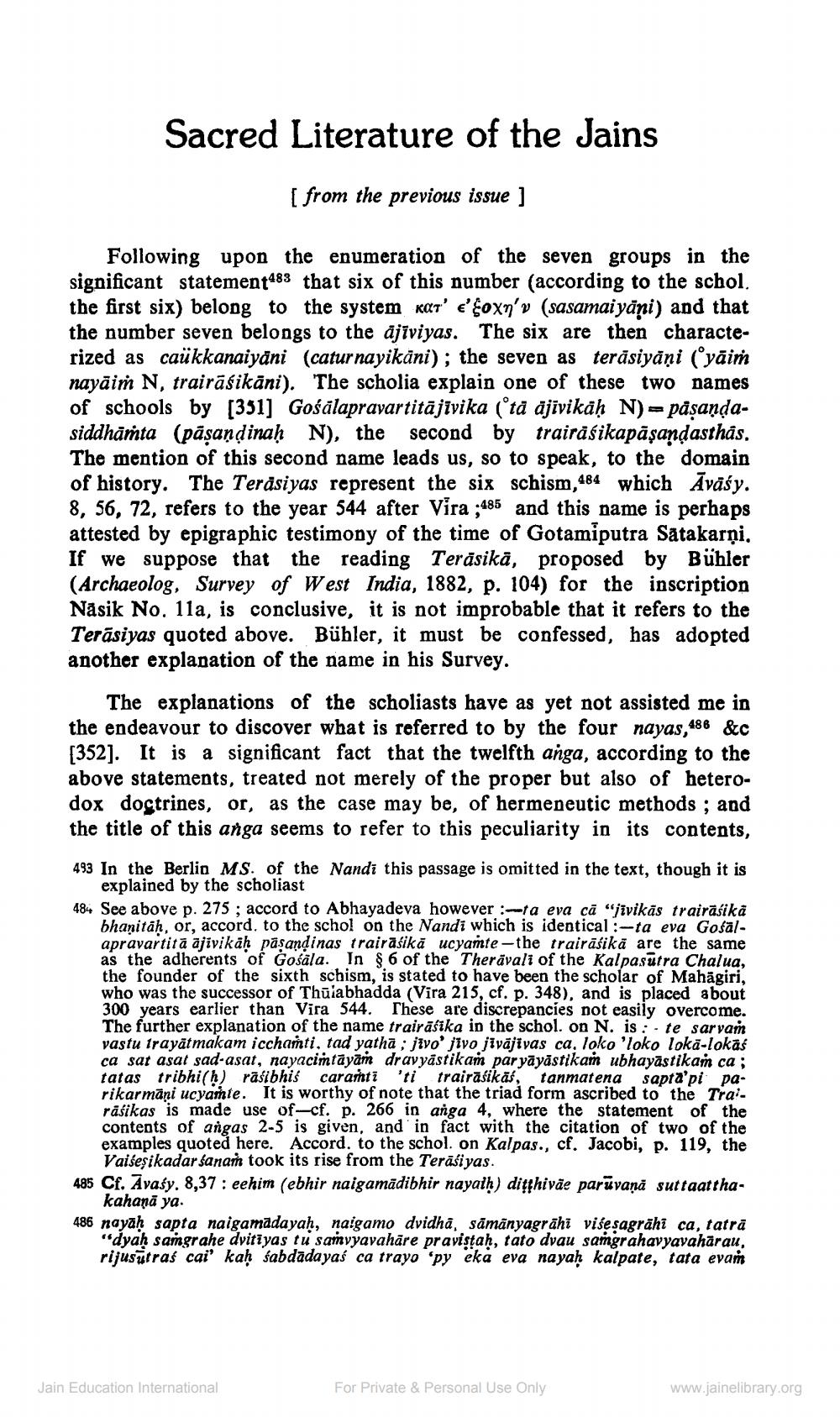________________
Sacred Literature of the Jains
[ from the previous issue ]
Following upon the enumeration of the seven groups in the significant statement483 that six of this number (according to the schol. the first six) belong to the system kat' e'loxy'v (sasamaiyāni) and that the number seven belongs to the ajīviyas. The six are then characterized as caükkanaiyāni (catur nayikāni); the seven as terasiyåņi (yāim nayāim N, trairāśikāni). The scholia explain one of these two names of schools by [351] Gośālapravartitājivika ('ta äjivikaḥ N) - påşandasiddhāṁta (pasandinah N), the second by trairāśikapāşandasthas, The mention of this second name leads us, so to speak, to the domain of history. The Terasiyas represent the six schism,484 which Āvāśy. 8, 56, 72, refers to the year 544 after Vira ;485 and this name is perhaps attested by epigraphic testimony of the time of Got a Satakarni, If we suppose that the reading Teräsikā, proposed by Bühler (Archaeolog. Survey of West India, 1882, p. 104) for the inscription Nasik No. 11a, is conclusive, it is not improbable that it refers to the Terāsiyas quoted above. Bühler, it must be confessed, has adopted another explanation of the name in his Survey.
The explanations of the scholiasts have as yet not assisted me in the endeavour to discover what is referred to by the four nayas,486 &c [352]. It is a significant fact that the twelfth anga, according to the above statements, treated not merely of the proper but also of heterodox doctrines, or, as the case may be, of hermeneutic methods; and the title of this anga seems to refer to this peculiarity in its contents,
493 In the Berlin MS. of the Nandi this passage is omitted in the text, though it is
explained by the scholiast 484 See above p. 275 ; accord to Abhayadeva however ta eva cā "jivikäs trairāśika
bhanitäh, or, accord, to the schol on the Nandi which is identical :-ta eva Gosalapravartitā ājivikah pasandinas trairāśikā ucyante - the trairāśikā are the same as the adherents of Gośāla. In § 6 of the Therävali of the Kalpasutra Chalua, the founder of the sixth schism, is stated to have been the scholar of Mahägiri. who was the successor of Thūiabhadda (Vira 215, cf. p. 348), and is placed about 300 years earlier than Vira 544. These are discrepancies not easily overcome. The further explanation of the name trairāśika in the schol. on N. is :- te sarvam vastu trayātmakam icchati, tad yathā , jivo' jivo jivāji vas ca, loko 'loko lokā-lokas ca sat asat sad-asat, nayacimtayam dravyästikam par yāyāstikam ubhayāstikan ca; tatas tribhi(h) rāśibhis caraħti 'ti trairāśikās, tanmatena sapta'pi parikarmāni ucyante. It is worthy of note that the triad form ascribed to the Trai. rāśikas is made use of-cf. p. 266 in anga 4, where the statement of the contents of angas 2-5 is given, and in fact with the citation of two of the examples quoted here. Accord. to the schol. on Kalpas., cf. Jacobi, p. 119, the
Vaibesikadar Sanań took its rise from the Terāśiyas. 485 Cf. Avasy. 8,37: eehim (ebhir naigamādibhir nayath) dithivãe paruvană suttaattha
kahana ya. 486 nayah sapta naigamadayah, naigamo dvidha, sämänyagrāhi visesagrāhi ca, tatrā
"dyah sangrahe dvitiyas tu samvyavahāre pravistah, tato dvau sangrahavyavahārau, rijusutras cai' kah sabdadayaś ca trayo 'py eka eva nayah kalpate, tata evan
Jain Education International
For Private & Personal Use Only
www.jainelibrary.org




